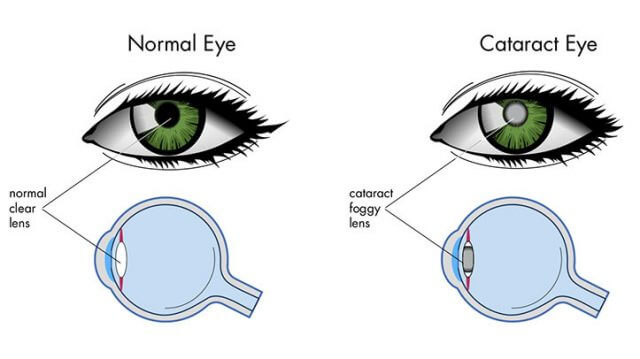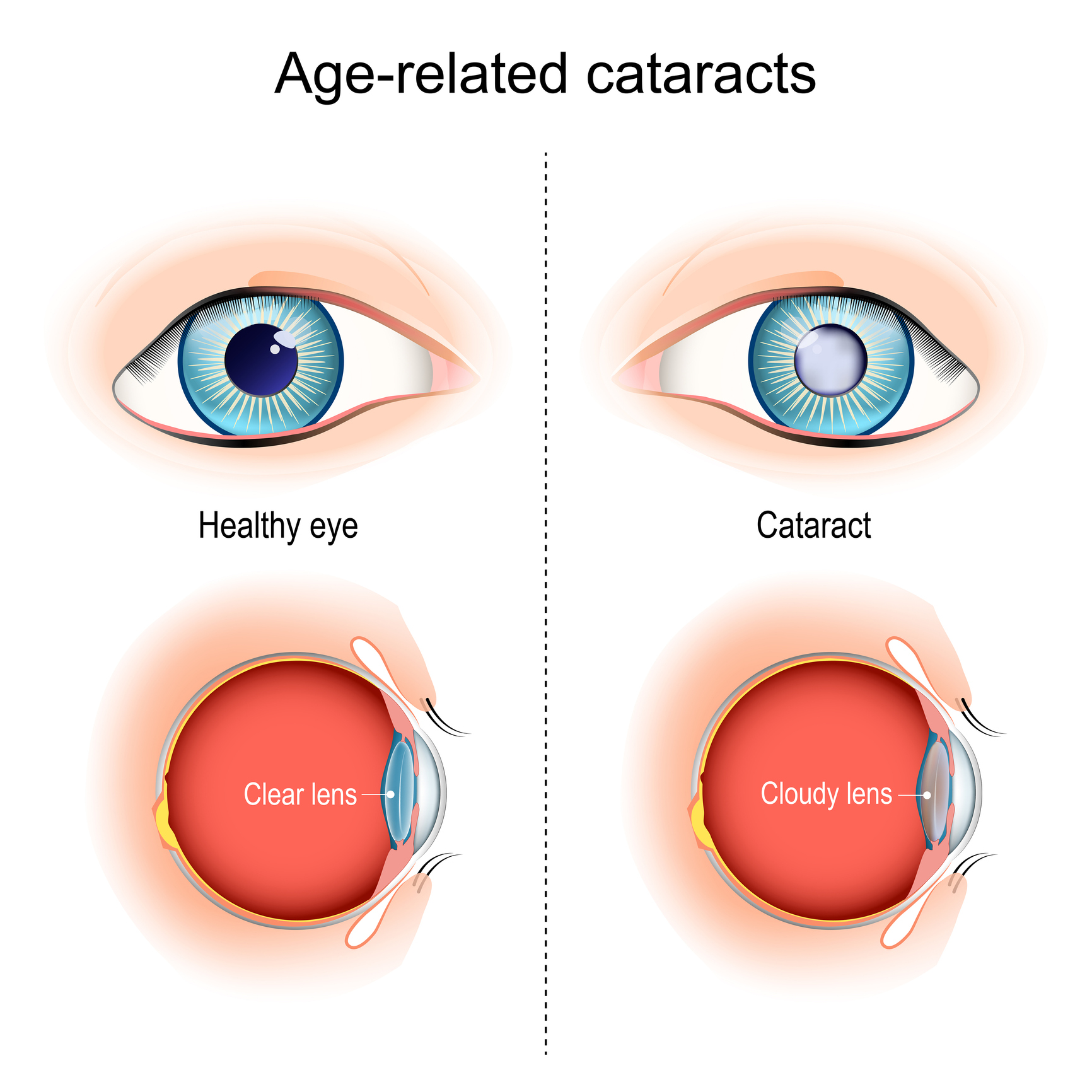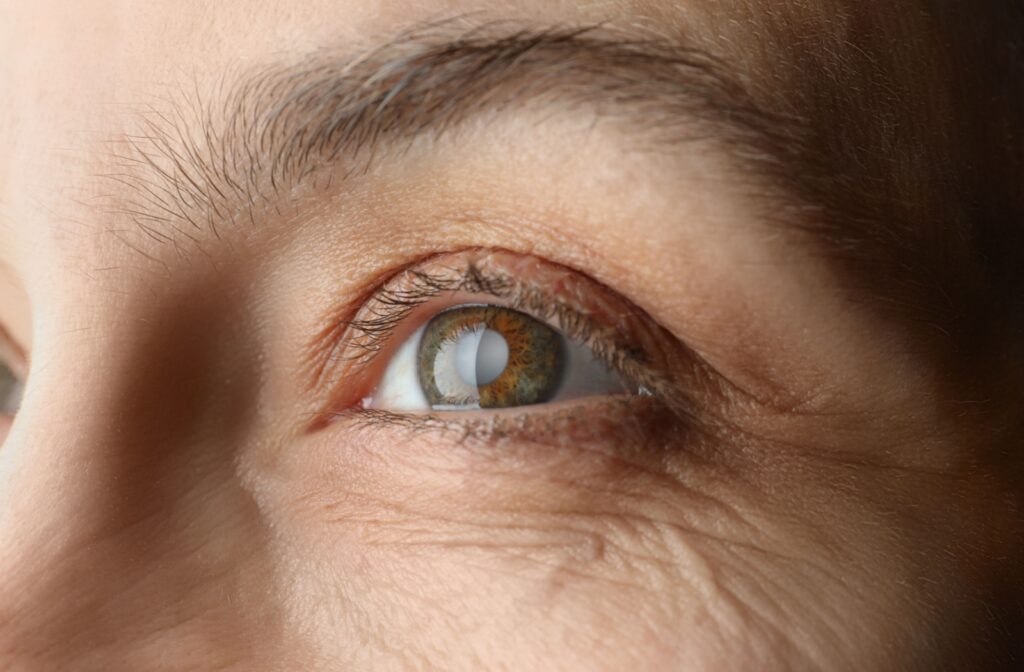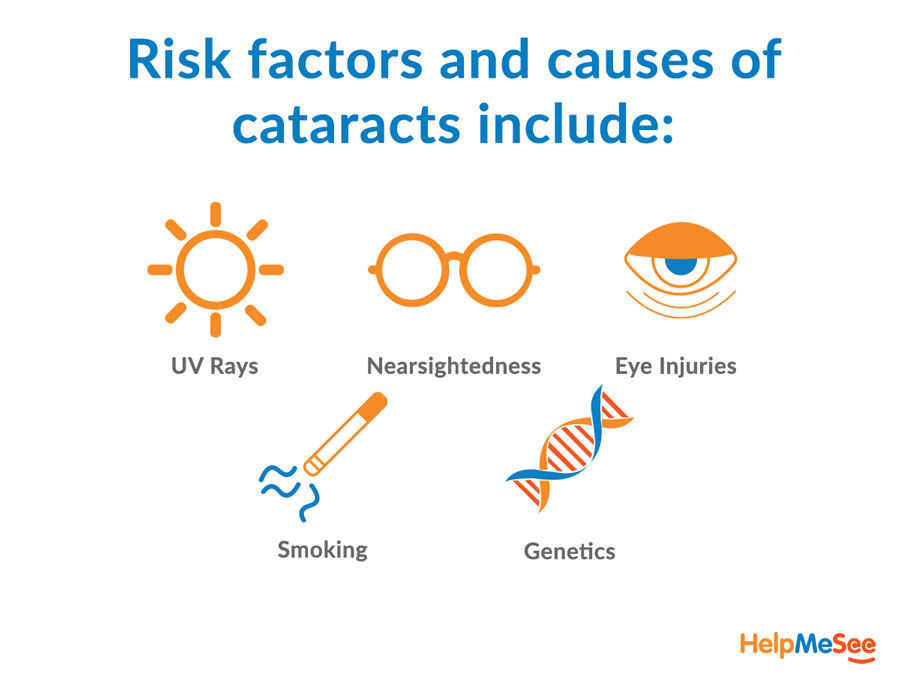Cataract meaning-various-aspects-
A cataract refers to the clouding of the eye’s lens, which is normally clear. For individuals with cataracts, viewing through clouded lenses resembles looking through a window that is frosted or foggy. The blurred vision resulting from cataracts can complicate reading, driving at night, or observing a friend’s facial expressions.
Most cataracts form gradually and do not initially interfere with vision. However, over time, cataracts will ultimately impact eyesight.
Initially, increased lighting and glasses can assist in managing cataracts. However, if compromised vision hinders daily activities, cataract surgery may be necessary. Thankfully, cataract surgery is usually a safe and effective treatment.


Types of cataracts
There exist numerous types of cataracts. This article concentrates on age-related cataracts. Additional types of cataracts include:


Pediatric cataracts. Pediatric cataracts influence infants and young children. Infants may be born with cataracts (congenital), or the cataracts may develop at some point following birth. Pediatric cataracts usually have a hereditary component, but they can also arise from eye injuries or other ocular conditions. Infants and children with pediatric cataracts require immediate treatment to avert complications such as amblyopia (lazy eye).
Traumatic cataracts. These cataracts develop when your eye sustains an injury. Treatment for this kind is more complex because surrounding structures may also require repair.
Secondary cataracts. These are opacities that develop on your lens capsule, or the membrane enveloping your lens. Another name for this issue is posterior capsular opacification. It is a frequent but readily treatable complication following cataract surgery.
Types of age-related cataracts
There are different kinds of age-related cataracts. Their names indicate their position within your lens. To grasp these types, it is useful to have a basic understanding of your lens’s anatomy.


Your lens consists of several layers. You may envision them as the layers of an apple:
- The nucleus is situated in the center of your lens. It is akin to the apple’s core.
- The cortex is the layer encircling the nucleus. It is like the edible fruit that surrounds the core.
- The lens capsule is the delicate membrane that covers the cortex. Technically, it is not part of the lens itself, but rather resembles a snug skin that encases and safeguards the lens. The lens capsule is somewhat comparable to the skin of the apple.
Eye care professionals categorize cataracts based on their location within your lens. Frequently, individuals have multiple types simultaneously. This is due to the fact that it is common for cloudy areas to develop in various regions of your lens. The three most prevalent types of age-related cataracts are:
- Nuclear sclerotic cataract, which develops in the nucleus.
- Cortical cataract, which develops in the cortex.
- Posterior subcapsular cataract, which develops in the posterior cortex. “Posterior” in this scenario denotes the “back” of your lens. This is the section closest to your retina (located behind your lens). “Subcapsular” signifies that the cataract forms at the outer boundary of the cortex, just below the lens capsule.
If any patient of ENT requires any surgery, opd consultation or online consultation in clinic of ENT specialist Doctor Dr Sagar Rajkuwar ,he may contact him at the following address-
Prabha ENT clinic, plot no 345,Saigram colony, opposite Indoline furniture Ambad link road, Ambad ,1 km from Pathardi phata Nashik ,422010, Maharashtra, India-Dr Sagar Rajkuwar (MS-ENT), Cell no- 7387590194 , 9892596635
Issued in public interest by –


At what age do cataracts usually start?
The proteins within your eye’s lens begin to deteriorate around the age of 40. However, you generally won’t observe symptoms until you reach age 60 or older. Certain health conditions, such as diabetes, may lead you to experience symptoms earlier.
For update on further important health related topics and frequently asked questions on health topics by general population please click on the link given below to join our WhatsApp group –
https://chat.whatsapp.com/Lv3NbcguOBS5ow6X9DpMMA
Issued in public interest by –
How common are cataracts?
Cataracts are quite prevalent in the U. S. as well as globally. The World Health Organization reports that roughly 17% of individuals worldwide suffer from cataracts that hinder their vision. Nevertheless, the occurrence differs significantly across countries and regions. A higher incidence is found in middle-income and low-income countries where individuals usually face more risk factors and have restricted access to cataract treatment.
FOR INFORMATION IN GREAT DETAIL ON Difference between glaucoma and cataract PL CLICK ON THE LINK GIVEN BELOW-It Is Always Better To View Links From Laptop/Desktop Rather Than Mobile Phone As They May Not Be Seen From Mobile Phone. ,In Case Of Technical Difficulties You Need To Copy Paste This Link In Google Search. In Case If You Are Viewing This Blog From Mobile Phone You Need To Click On The Three Dots On The Right Upper Corner Of Your Mobile Screen And ENABLE DESKTOP VERSION.
FOR INFORMATION IN GREAT DETAIL ON Cataract Surgery PL CLICK ON THE LINK GIVEN BELOW-It Is Always Better To View Links From Laptop/Desktop Rather Than Mobile Phone As They May Not Be Seen From Mobile Phone. ,In Case Of Technical Difficulties You Need To Copy Paste This Link In Google Search. In Case If You Are Viewing This Blog From Mobile Phone You Need To Click On The Three Dots On The Right Upper Corner Of Your Mobile Screen And ENABLE DESKTOP VERSION.
FOR INFORMATION IN GREAT DETAIL ON What are the 3 types of cataract surgery PL CLICK ON THE LINK GIVEN BELOW-It Is Always Better To View Links From Laptop/Desktop Rather Than Mobile Phone As They May Not Be Seen From Mobile Phone. ,In Case Of Technical Difficulties You Need To Copy Paste This Link In Google Search. In Case If You Are Viewing This Blog From Mobile Phone You Need To Click On The Three Dots On The Right Upper Corner Of Your Mobile Screen And ENABLE DESKTOP VERSION.
FOR INFORMATION IN GREAT DETAIL ON How long to wear eye shield at night after cataract surgery PL CLICK ON THE LINK GIVEN BELOW-It Is Always Better To View Links From Laptop/Desktop Rather Than Mobile Phone As They May Not Be Seen From Mobile Phone. ,In Case Of Technical Difficulties You Need To Copy Paste This Link In Google Search. In Case If You Are Viewing This Blog From Mobile Phone You Need To Click On The Three Dots On The Right Upper Corner Of Your Mobile Screen And ENABLE DESKTOP VERSION.
FOR INFORMATION IN GREAT DETAIL ON Cataract Symptoms PL CLICK ON THE LINK GIVEN BELOW-It Is Always Better To View Links From Laptop/Desktop Rather Than Mobile Phone As They May Not Be Seen From Mobile Phone. ,In Case Of Technical Difficulties You Need To Copy Paste This Link In Google Search. In Case If You Are Viewing This Blog From Mobile Phone You Need To Click On The Three Dots On The Right Upper Corner Of Your Mobile Screen And ENABLE DESKTOP VERSION.
FOR INFORMATION IN GREAT DETAIL ON Cortical cataract PL CLICK ON THE LINK GIVEN BELOW-It Is Always Better To View Links From Laptop/Desktop Rather Than Mobile Phone As They May Not Be Seen From Mobile Phone. ,In Case Of Technical Difficulties You Need To Copy Paste This Link In Google Search. In Case If You Are Viewing This Blog From Mobile Phone You Need To Click On The Three Dots On The Right Upper Corner Of Your Mobile Screen And ENABLE DESKTOP VERSION.
If Any Patient of ENT Requires Any Surgery, Opd Consultation Or Online Consultation In Clinic of ENT Specialist Doctor Dr. Sagar Rajkuwar ,He May Contact Him At The Following Address-
Prabha ENT Clinic, Plot no 345,Saigram Colony, Opposite Indoline Furniture Ambad Link Road ,Ambad ,1 km From Pathardi Phata Nashik ,422010 ,Maharashtra, India-Dr. Sagar Rajkuwar (MS-ENT), Cell No- 7387590194, 9892596635
Issued in public interest by –
If you are from Nashik Maharashtra and having any eye/ophthalmic problem then you may take appointment with -Birla eye hospital, B-180, Opposite Zilla Parishad,, Trimbak Road, near Pooja Internatinal Hotel, Nashik, Maharashtra 422002,
Phone no -02532505666
If you are not from Nasy but from India then you may dial -8888888888-this is no of Just dial and they may provide you the contact number and adress off eye specialist doctor near your locality .In any case it is always better to take opinion from your regular doctor whom you trust,/respect so that he can let you know details of senior and experienced eye specialist doctor/ophthalmologist
Any ophthalmologist with minimum of 10 yrs experience is considered senior
Cataract Symptoms-various aspects-
Cataracts, which cause the eye’s lens to become cloudy, can result in various changes to vision. Common symptoms include blurred or dimmed vision, difficulties seeing in low light, sensitivity to light and glare, and a greater need for brightness when reading. Some people may also observe halos around lights, a constant change in their eyeglass prescriptions, or a dulling or yellowish hue in colors.

Specific signs of cataracts may encompass
- Blurred or cloudy vision: A clouded lens can result in a hazy or less distinct visual experience.
- Nighttime visibility issues: Cataracts can make it harder to see in low light.
- Light and glare sensitivity: Bright electric lights or sunlight can create glare and become harsh.
- Halos around lights: A common sign is the observation of rings or circles encircling lights, especially at night.
- Need for Brighter Reading Light: People with cataracts may need more light to read comfortably.
- Frequent adjustments to eyeglasses or contact lenses prescriptions: The prescription may need to be changed more frequently as the cataract develops.
- Dulling or yellowing of colors: Colors might appear less brilliant or have a yellowish tint.
- Double vision in one eye: Cataracts can occasionally cause double vision in one eye, which may disappear as the cataract grows.
If Any Patient of ENT Requires Any Surgery, Opd Consultation Or Online Consultation In Clinic of ENT Specialist Doctor Dr. Sagar Rajkuwar ,He May Contact Him At The Following Address-
Prabha ENT Clinic, Plot no 345,Saigram Colony, Opposite Indoline Furniture Ambad Link Road ,Ambad ,1 km From Pathardi Phata Nashik ,422010 ,Maharashtra, India-Dr. Sagar Rajkuwar (MS-ENT), Cell No- 7387590194, 9892596635
It’s important to realize that cataracts progress slowly and may not cause serious vision problems at first. The symptoms become more noticeable as they grow larger. It is always best to get a complete eye exam from an eye care specialist if you notice any changes in your vision.
A cataract is the condition in which the normally clear lens of the eye becomes opaque. For people with cataracts, seeing through cloudy lenses is akin to looking through a frosted or hazy glass. Cataracts can cause blurred vision, making it difficult to see a friend’s expressions, read, or drive at night.
The majority of cataracts develop slowly and do not affect vision in their initial stages. But eventually, cataracts will affect vision.
Cataracts can be managed with enhanced lighting and prescription eyewear at first. However, cataract surgery may be required if impaired vision disrupts daily tasks. Cataract surgery is usually a safe and successful operation, which is a good thing.
Symptoms

Symptoms of cataracts consist of:
- Cloudy, blurry, or dim vision.
- Challenge with nighttime vision.
- Sensitivity to light and glare.
- the need for brighter lights for reading and other activities.
- Observing “halos” about lights.
- Regular changes to contact lens or eyeglasses prescriptions.
- Colors that fade or yellow.
- double vision in a single eye.
At first, only a tiny area of the eye’s lens may be affected by the cataract-related cloudiness in your vision. You may not notice any vision loss. The cataract clouds a larger portion of your lens as it grows. The light that enters the lens is changed by greater clouding. As a result, you might be able to see symptoms more clearly.
When to see a doctor
If you notice any changes in your vision, book an appointment for an eye exam. Consult a member of your healthcare team right away if you have abrupt vision changes like double vision or flashes of light, sudden eye discomfort, or a sudden headache.
Causes
The majority of cataracts develop when aging or trauma changes the tissue that makes up the eye’s lens, causing the lens’s proteins and fibers to break down. As a result, vision becomes cloudy or hazy.
Your risk of developing cataracts may be increased by some genetic disorders that cause other health problems. Cataracts can also be brought on by other eye diseases, past eye surgeries, or medical conditions like diabetes. Cataract formation can also be aided by prolonged use of steroid medications.
How A Cataract Forms
A cataract is defined by a cloudy lens. The lens is placed behind the iris, the colored part of your eye. The lens focuses the light that enters your eye. This produces bright, crisp pictures on the rear of the eye, known as the retina.
As you get older, the lenses of your eyes lose thickness, clarity, and flexibility. The aggregation and degradation of fibers and proteins in the lenses can be caused by aging and some medical disorders. This causes the lenses to become cloudy.
For Update On Further Important Health Related Topics And Frequently Asked Questions On Health Topics By General Population Please Click On The Link Given Below To Join Our WhatsApp Group –
https://chat.whatsapp.com/Lv3NbcguOBS5ow6X9DpMMA
The clouding worsens as the cataract grows. A cataract scatters and blocks light that passes through the lens. This prevents a sharply defined image from reaching the retina. As a result, your vision becomes unclear.
Although not always at the same rate, cataracts commonly develop in both eyes. There may be a difference in vision between the eyes if one eye’s cataract is more severe than the other.
Risk factors

Factors that elevate your chances of developing cataracts consist of:
- Getting older.
- Diabetes.
- Too much sun exposure.
- Smoking.
- Obesity.
- Cataract genetic susceptibility.
- Previous eye injury or inflammation.
- The history of eye operations.
- Prolonged use of corticosteroid drugs.
- Consuming too much alcohol.
Prevention
Although no research has proven conclusive ways to prevent or delay the onset of cataracts, medical experts think that a number of approaches may be useful, such as:
- Regular eye exams. Eye examinations can help detect cataracts and other eye problems early on. Talk to your healthcare professionals about how often you should have eye exams.
- Refrain from smoking. Ask a member of your healthcare team for advice on quitting smoking. You may get help through counseling, medicine, and other approaches.
- Follow your treatment plan if you have diabetes or any other health problems that could increase your risk of cataracts.
- Choose a healthy diet that includes plenty of fruits and vegetables. You are sure to be getting a variety of vitamins and nutrients when you include fruits and vegetables in your meals. Antioxidants found in fruits and vegetables help protect your eyes health.
Research has not confirmed that antioxidants in supplement form can avert cataracts. However, a substantial population study recently indicated that a nutritious diet abundant in vitamins and minerals lowered the likelihood of developing cataracts. Fruits and vegetables offer numerous verified health advantages. Consuming them is a secure approach to obtain sufficient vitamins and minerals in your diet.
- Use sunglasses. Ultraviolet rays from the sun may contribute to cataracts. Wear sunglasses that block ultraviolet B rays when you are outdoors.
- Limit alcohol consumption. Excessive drinking can elevate the risk of cataracts.





